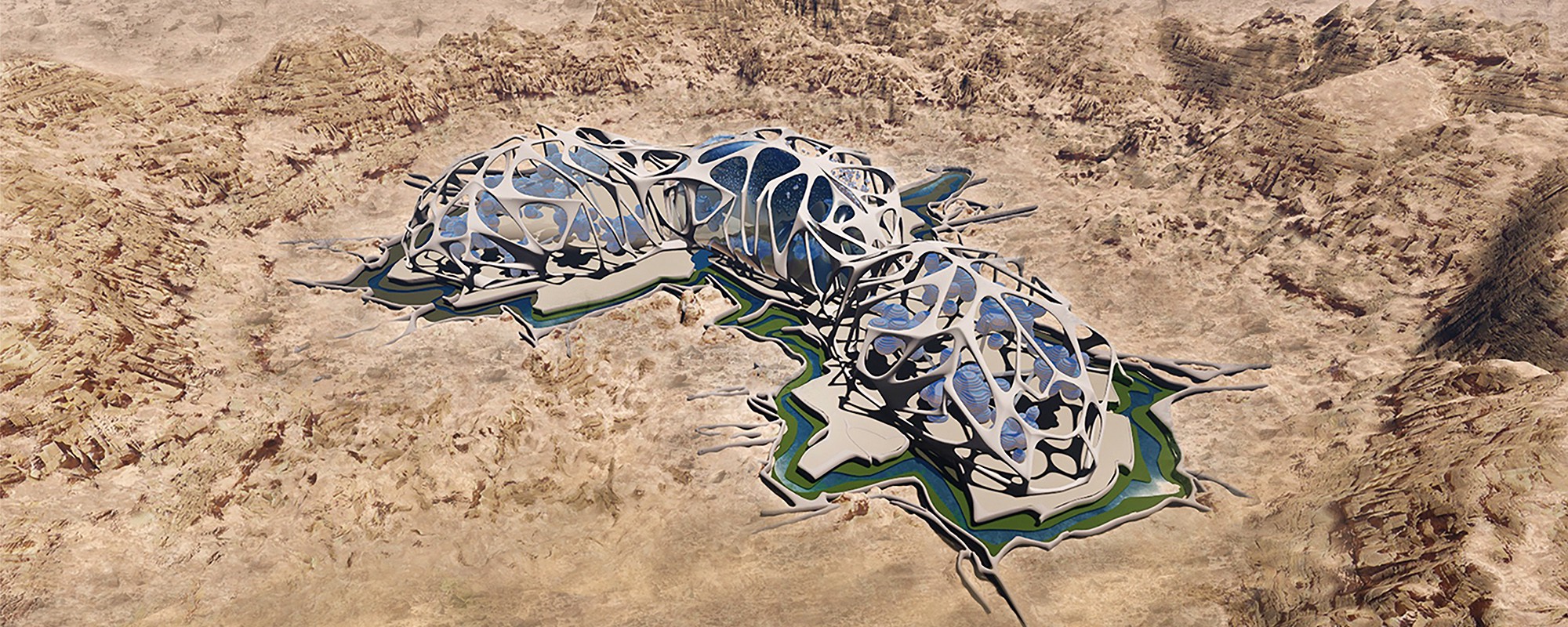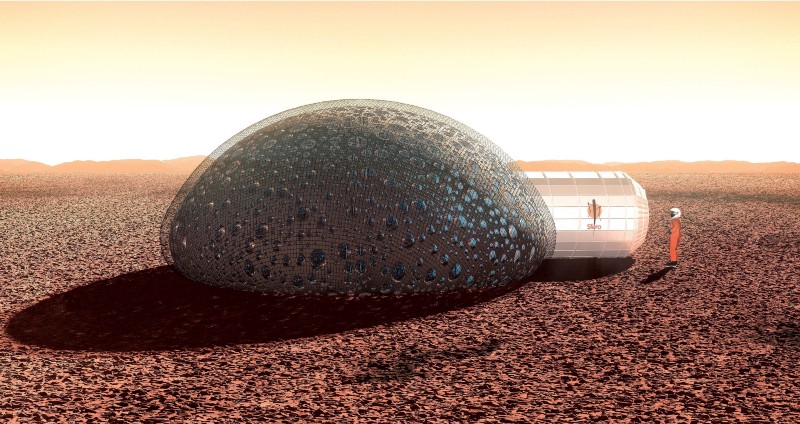

Having lived all around the world, Vera Mulyani now wants to help design the first city on Mars. Describing herself as the world’s first “Marschitect,” she is the founder of Mars City Design, an innovative project that counts Apollo 11 astronaut Buzz Aldrin among its backers.
Born in Jakarta, Indonesia, Mulyani studied architecture in France and film in New York, followed by stints in Hong Kong, China, and Egypt, before moving to Santa Monica, California, where she currently resides. She has an ambitious vision–establishing a base on the Red Planet for four people, and eventually growing the settlement to the size of an entire city with over 1,000 inhabitants. The scheme brings together architects, scientists, and technologists tasked with conceptualizing a blueprint for a city on Mars.
Designing space habitats–either for use in low Earth orbit, the Moon, or on Mars–is not new. But as SpaceX and Blue Origin are pushing the boundaries for human exploration of the cosmos, space architecture is on the verge of becoming a much larger industry.

So far, most architecture projects for other planets are still on the drawing board. However, there are several such drawing boards in progress–design competitions like NASA’s 3D-Print Habitat Challenge or Google’s Lunar XPRIZE are bringing the full-scale realization of innovative space designs closer.
The field is also not short of more creative ideas for how we could live on other worlds. French design company Fabulous has suggested 3D-printed bubble houses for living on Mars, while ZA Architects have designed underground dwellings dug out of the planet’s bedrock by solar-powered machines. Karan Gandhi’s “Neurosynthesis” includes an artificial waterfall and ambulatory housing, while others have envisaged projects as wild as a Tate Gallery in space or an Olympic Stadium on the Moon.

How seriously can we take these designs?
Space architecture is an “unrecognized, and therefore not respected, skill by the aerospace industry, nor by the American Institute of Architects,” explained Kriss J. Kennedy–an exploration habitat expert and licensed architect who has been working with NASA since 1987.
Mars City Design is hoping to bring Martian architecture to life during an upcoming workshop at the University of Southern California between September 15″”28, 2016, which Kennedy will take part in. Within the next three years, the initiative wants to be 3D-printing all its design prototypes to scale in the Mojave Desert.
That’s mostly because, to date, the space community has been preoccupied with astronaut survival, rather than what its habitat feels or looks like. Yet, “in an industry that is risk averse, space architects can offer [useful] big-picture thinking,” said Carnegie Mellon University Mars Studios lecturer Christina Ciardullo, who will also join the USC conference.

What makes a well-designed Martian habitat?
A good conceptual design for a Martian dwelling should take into account the multitude of reasons that make us want to go to the Red Planet in the first place–from scientific exploration to the extraterrestrial experience.
There are standard attributes that a Martian habitat should have–sustainability, zero-net energy consumption, and backup systems for its pressurized areas. But balancing between survival and habitability is key. Martian habitats should “broaden the possibilities for humans to experience their new environment, in a way less mediated by bulky equipment around them,” said Ciardullo.
The design of such a habitat should make it possible for its dwellers to regularly exercise, enhance their health, eat, and sleep. The underlying technology should enable us to “live comfortably in a condition that is extreme–being on Mars,” Mulyani said.
Building homes–or even cities–on other planets creates a whole new set of challenges that we’ve never encountered before. Scarce water resources, for example, mean that making concrete is difficult. “The transportation, operation, and maintenance of the machines bring many difficulties in building habitats on Mars,” said Lin Wan, a researcher who has developed a way to make Martian concrete without water from a mixture of sulphur and regolith.
Using inflatable structures is a promising alternative to hard modules. Bigelow Aerospace’s inflatable habitats, for example, can be folded up like a parachute and reduced to nearly one-fifth their inflated size–handy for transport from Earth.

How would urban planning work on Mars?
Developing forward-thinking space architecture, however, is only the first step toward Mars colonization. “If we randomly install a base somewhere, it will become a mess–just like on Earth,” said Mulyani. She compares the Le Corbusier-designed Indian city of Chandigarh, its cleanliness and lack of traffic, with Delhi’s chaos.
That’s why, unlike most projects for the Red Planet, Mars City Design is focusing on the city level. “We start with thinking how the entire city is conceptually designed–the habitat follows,” she explained.
“The aspect of the infrastructure is paramount–resources, transportation, utility distribution, and the site itself,” said Kennedy, agreeing that we should begin with thinking about the end state, the development phases, and process by which we mature a Martian city. “Whether above ground, underground, or a combination of the two, the planning of urban design is key to the successful outcome of a city.”
Architecture has been forever linked to humanity’s evolution, and space architecture is just the next phase. As we seek to become a multi-planet species, architectural technology will allow us to live comfortably in extreme conditions on other worlds, just as it has in the tundra, in deserts, and on top of mountains on Earth.
“What excites me the most is that space architecture will be on the forefront of space development,” said Kennedy. “This is a tremendous adventure that will forever change humanity.”


How We Get To Next was a magazine that explored the future of science, technology, and culture from 2014 to 2019. This article is part of our Above & Beyond section, which looks at our understanding of the universe beyond Earth. Click the logo to read more.
